Review: Hover Camera Passport drone is light and takes good pictures, suffers from poor su...
Despite online documentation support and instructions charitably described as a nightmare, the Hover Camera Passport is a good solution for most -- but only time, and usage tells the tale.
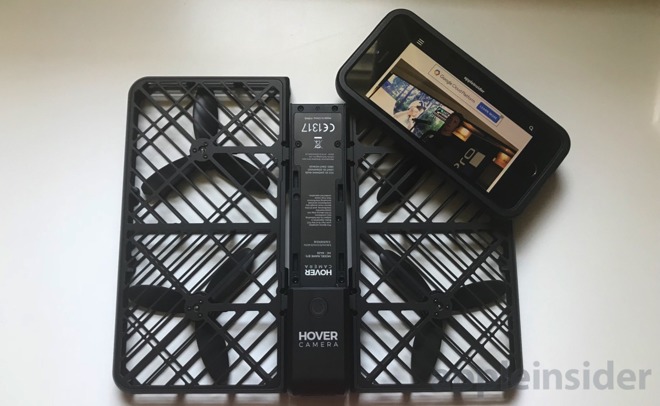
The Hover Camera Passport shipped at the end of 2016 for $599 as an Apple Store exclusive and promised to be a gateway for easy drone photography -- a flying "selfie stick," as it were, and available only from Apple. The hardware has since dropped to $499, and remains as an Apple Store exclusive and is featured prominently in some Apple Retail point-of-purchase displays.
There's a reason why Apple stocks it. The Hover Camera Passport is solidly designed, with the box designed to be a storage bunker for accessories and components for the drone. A zipper case holds the drone itself and the two batteries that ship with the unit.
The batteries change from empty to full in the provided charger in about an hour.
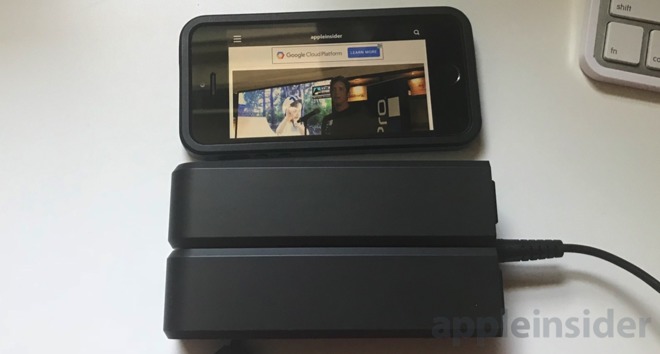
The drone is controlled through an iPhone app, and connects through a private wi-fi network generated by the drone itself. A tutorial in the app takes the user through the basic features of the drone, but neglects one crucial step -- a firmware update check.
If you've got one built recently, this is probably fine. If you've got stock that's been sitting around for a while, not so much.
The drone that was supplied to AppleInsider had ridiculously outdated firmware, and as such, during the early tutorials, the drone wouldn't return and was out of reach.
Exacerbating the problem, advanced features like manual control and the automated emergency landing command aren't available until the tutorials which include launching the drone are complete. So, we were in a position where the drone hadn't locked on to us, and gesture controls weren't being recognized.
As a result, the drone drifted away and climbed about 20 feet away from us, perilously close to a roof sounding like an angry bee swarm the entire time.
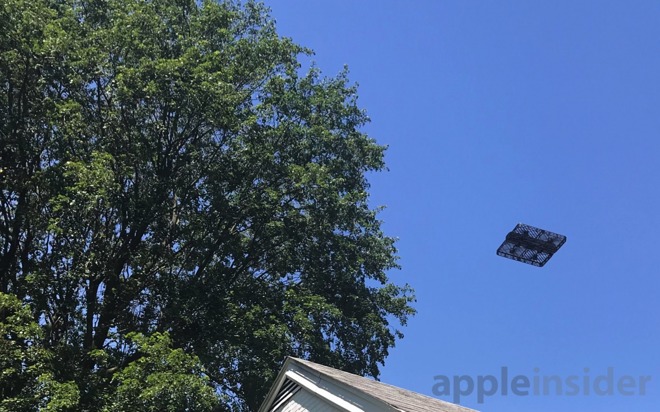
Fortunately, in a low-power situation, the drone uses it's downward-pointing camera to gently land, so we just waited out the battery, and got lucky with the roof proximity.
We've since completed the tutorial, and have updated the firmware on the drone. This still isn't the best situation, and should be done in an area with the best possible LTE signal -- as there is no restarting a failed download.
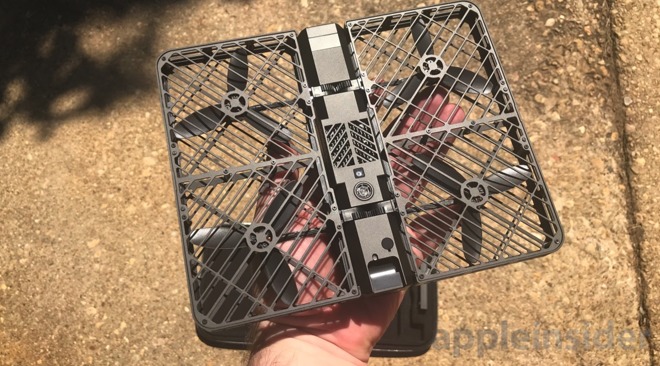
Since the firmware update crisis, we've had a better time with the drone. Maximum range is said to be about 35 feet from the controlling phone, but we didn't lose communication to the drone until closer to 75 feet.
The assorted lock-on features and flight modes worked fine. Still images were full of color, and clear.
However, when shooting video the drone is -- for lack of a better term -- jittery, and this is clear when you look at what you shot. Don't cut resolution down to 1080p and hope for better -- because you won't get it. Stick with 4K and apply image stabilization in video editing tools.
The video below won't expand into 4K when embedded in Safari. Click through to YouTube for 4K options.
The Hover Camera Passport has many right angles that cross-winds can grab. In the range-testing process, we flew the drone up the side of a sound-retaining wall -- and immediately hit brutal drafts from the highway traffic when we crested the top.
Using a heavier and more aerodynamic DJI Phantom 3, we didn't have much in the way of buffeting from the highway. However, the Hover Camera Passport struggled with the updrafts from the traffic.
Fortunately, we didn't lose all control, and the app continued to communicate with the drone fine even while being tossed about. We managed to get it back, and stability was regained when we dropped below the level of the wall.
The DJI Phantom 3 that we were using for comparative testing lasted for around 22 minutes, with an inferior camera.
But, the Phantom 3 is bigger and heavier. Its less able to be tossed in a bag, and deployed at a moment's notice than the Hover Camera Passport is.
However -- there's a new challenger. The DJI Spark also retails for $499. We're still looking at that one, but on paper edges out the Hover Camera Passport in flight time, speed, and range from the controlling app.
If the support assets for the drone are cleaned up, including how to perform a manual firmware update from macOS without flipping through four different support pages, this will go up an extra half point. We'll keep our eyes peeled.
If you're flying a drone just to fly, then the Hover Camera Passport is not for you, and it's a 2 out of 5. It doesn't stay aloft long enough, and flying it in any kind of weather is rough.
But, If you're taking a hike or something, it can be an effort to haul around a drone with a long flight time like the Phantom 3. The case for the Hover Camera Passport can be easily crammed in a backpack or day-bag and brought along without much regard for support equipment or a hard case -- in this case, the drone is a solid 4 out of 5.

The Hover Camera Passport shipped at the end of 2016 for $599 as an Apple Store exclusive and promised to be a gateway for easy drone photography -- a flying "selfie stick," as it were, and available only from Apple. The hardware has since dropped to $499, and remains as an Apple Store exclusive and is featured prominently in some Apple Retail point-of-purchase displays.
There's a reason why Apple stocks it. The Hover Camera Passport is solidly designed, with the box designed to be a storage bunker for accessories and components for the drone. A zipper case holds the drone itself and the two batteries that ship with the unit.
The batteries change from empty to full in the provided charger in about an hour.

The drone is controlled through an iPhone app, and connects through a private wi-fi network generated by the drone itself. A tutorial in the app takes the user through the basic features of the drone, but neglects one crucial step -- a firmware update check.
If you've got one built recently, this is probably fine. If you've got stock that's been sitting around for a while, not so much.
The drone that was supplied to AppleInsider had ridiculously outdated firmware, and as such, during the early tutorials, the drone wouldn't return and was out of reach.
Exacerbating the problem, advanced features like manual control and the automated emergency landing command aren't available until the tutorials which include launching the drone are complete. So, we were in a position where the drone hadn't locked on to us, and gesture controls weren't being recognized.
As a result, the drone drifted away and climbed about 20 feet away from us, perilously close to a roof sounding like an angry bee swarm the entire time.

Fortunately, in a low-power situation, the drone uses it's downward-pointing camera to gently land, so we just waited out the battery, and got lucky with the roof proximity.
We've since completed the tutorial, and have updated the firmware on the drone. This still isn't the best situation, and should be done in an area with the best possible LTE signal -- as there is no restarting a failed download.

Since the firmware update crisis, we've had a better time with the drone. Maximum range is said to be about 35 feet from the controlling phone, but we didn't lose communication to the drone until closer to 75 feet.
Actual flight
After initial operational and connectivity testing, we doled out the drone to relations more photogenic and better pilots than us.The assorted lock-on features and flight modes worked fine. Still images were full of color, and clear.
However, when shooting video the drone is -- for lack of a better term -- jittery, and this is clear when you look at what you shot. Don't cut resolution down to 1080p and hope for better -- because you won't get it. Stick with 4K and apply image stabilization in video editing tools.
The video below won't expand into 4K when embedded in Safari. Click through to YouTube for 4K options.
Beware of weather
Drones aren't planes, and are more akin to helicopters. As such, behavior in weather varies widely based on the geometry of the device.The Hover Camera Passport has many right angles that cross-winds can grab. In the range-testing process, we flew the drone up the side of a sound-retaining wall -- and immediately hit brutal drafts from the highway traffic when we crested the top.
Using a heavier and more aerodynamic DJI Phantom 3, we didn't have much in the way of buffeting from the highway. However, the Hover Camera Passport struggled with the updrafts from the traffic.
Fortunately, we didn't lose all control, and the app continued to communicate with the drone fine even while being tossed about. We managed to get it back, and stability was regained when we dropped below the level of the wall.
Battery life alters use cases
A drone is only as good as an airborne platform if it can stay aloft. The Hover Camera Passport has a maximum flight time of 9 minutes and 12 seconds in our static hover test, and 7 minutes and 41 seconds when filming.The DJI Phantom 3 that we were using for comparative testing lasted for around 22 minutes, with an inferior camera.
But, the Phantom 3 is bigger and heavier. Its less able to be tossed in a bag, and deployed at a moment's notice than the Hover Camera Passport is.
However -- there's a new challenger. The DJI Spark also retails for $499. We're still looking at that one, but on paper edges out the Hover Camera Passport in flight time, speed, and range from the controlling app.
Score: 3 out of 5

If the support assets for the drone are cleaned up, including how to perform a manual firmware update from macOS without flipping through four different support pages, this will go up an extra half point. We'll keep our eyes peeled.
Beyond the score
Tech is hard to quantify with a number. There's no universal scale of compatibility with every given use case.If you're flying a drone just to fly, then the Hover Camera Passport is not for you, and it's a 2 out of 5. It doesn't stay aloft long enough, and flying it in any kind of weather is rough.
But, If you're taking a hike or something, it can be an effort to haul around a drone with a long flight time like the Phantom 3. The case for the Hover Camera Passport can be easily crammed in a backpack or day-bag and brought along without much regard for support equipment or a hard case -- in this case, the drone is a solid 4 out of 5.

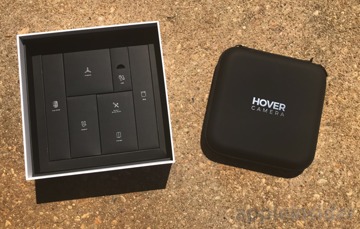
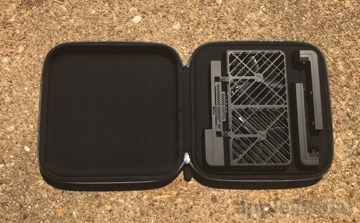

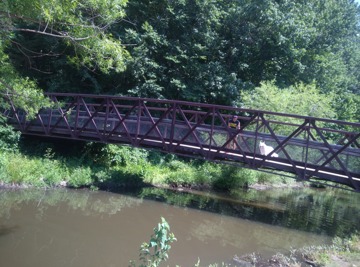
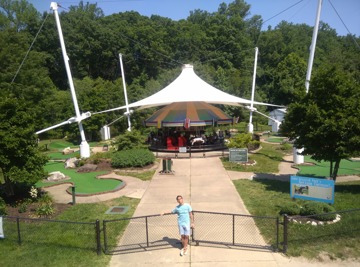
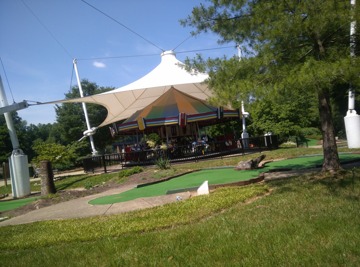


Comments
The jittery video is just off putting and makes me feel a bit sick whereas the DJI cameras and stabilisation work very very well out of the box.
Also agree that DJI's customer service is a bit average (being nice here) so you have to take that into account but ultimately it is about the video image that you get and the one from the Camera Passport is very bad.
Cheers Dr Hawk
Not mentioned in the review is the versatility of using the Hover Camera indoors for various video and photo shots, and where the elements are not a factor. I don't know about the other mentioned cameras, but the Hover is quite safe to fly indoors. Even Apple demoes the camera inside its stores—a big selling point for me along with its portability.
I agree than the manual and tutorials leave a lot to be desired, but I don't think applying firmware updates is a problem at all.
https://youtu.be/iPG1Xa5Uqwo
https://youtu.be/4xGAAjJkxxE
And look at the range on this thing:
https://youtu.be/SMQ8XVd6A44
https://youtu.be/WsHpdQPIMvI
Don’t follow my experience and don’t lose your money on disappeared Hover Camera drone
The Artificial Intelligence (AI) is a great topic and I’m a big fan of it. Both personally and professionally.
Since I found a first news about planned Hover Camera drone which adopts advanced AI for face and person recognition in video and uses it for the drone navigation I was among the first ones who submitted the liable pre-order, paid about $550 and waited about 1 year until the drone was finally founded launched and delivered to the middle of Europe to my home.
Unfortunately my pleasure last only for few days and the drone got very soon irrevocably lost. I tell you how it happened to let you avoid a similar experience.
It was winter and I took the drone to record my wife during the downhill skiing. There was a morning and was little bit foggy and bit windy (very common weather in my country).
I let the drone into the air and “lock” its focus to my wife.
First unexpected finding was the drone don’t follow the downhill slope but keep flying into the same attitude. So after few meters of skiing the vertical distance between the drone and recorded skier set in too big and the drone lost focus.
Secondly after several similar tries the drone suddenly climbed up from himself about 50 meters high, immediately lost connection with my phone and remote control app and disappeared somewhere to the side in direction of nearby forrest.
One and half day I spend by combining the forest and looking for it in high snow. Unsuccessfully. The drone was gone and my $550 was gone.
Now, was the cause the little foggy weather that makes the drone think the ground is approaching so let’s claim up? Or the white show ground that was indistinguishable for AI sensors in the drone brain? Or something else? Nobody knows.
The most funny of this sad story at the end was the reaction of the drone producer (Zero Zero Robotics) when I claimed such a bug and strange behaviour of the drone what causes loosing it in the fog, high attitude and nearby forrest when I used their product for its essential purpose - recording me and my family during the outside sport activities.
Their answer was in the meaning - Are you mad? Using this drone in so improper environments? Did you read the enclosed terms & conditions (T&C)? In the T&C we clearly state that you “can’t use the drone in rain, fog, lighting, hail, storm, winds, or any other weather. Also avoid flying over surfaces with solid color (!), reflective or transparent, moving surfaces, strong sound absorption, irregular or unclear texture, repetitive textures, inclines and snow”. We even send you the copy of the subjected articles from our T&C. (attached).
If you don’t follow those instructions we don’t take any responsibility for any damages and losses.
Could you show me a single place on the planet which precisely meets such conditions?!
So if I got it right the only proper and suggested usage of the drone is in very unique laboratory conditions without any weather conditions with psychedelic texture on the floor. No outside, no weather, no light, no darkness, no single possible ground texture, no action, no sport, no real life.
Am I right?
What is the drone for, anyway?
The conclusion. The AI is great and emerging topic as well as video object recognition and drone navigation. Unfortunately the application of it in this particular product is not good enough to fulfil its very essential purpose - to record sport and adventure recordings. And the responsibility feelings of the product maker is simply childish and it’s a no-go for anyone who is thinking about buying such a product.